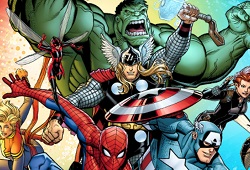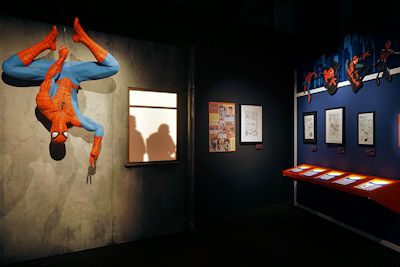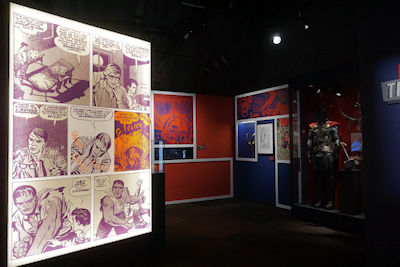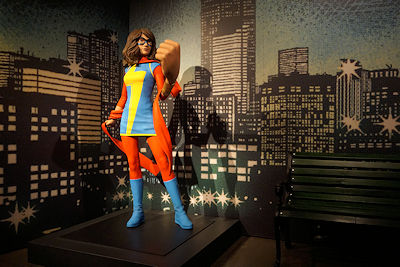
Captain America. The Fantastic Four. Spider-Man. The Hulk. Thor. Iron Man. Black Panther. Hawkeye. Black Widow. Captain Marvel. Ant-Man. The Wasp. Daredevil. Doctor Strange. Vision. The Scarlet Witch. Guardians of the Galaxy. The X-Men. Nick Fury. Luke Cage. Jessica Jones.
The Marvel Universe is vast, filled with superheroes of every type imaginable and a growing diversity that continues to increase as the years roll along. Although it wasn’t until the 1960s that the majority of these characters made their initial appearance, Marvel Comics has existed in one form or another since 1939 when the then Timely Comics published its first comic book and initial collection of superheroes – the original Human Torch and Namor the Sub-Mariner.
In preparation for the eightieth anniversary of Marvel Comics #1, the Museum of Pop Culture in Seattle teamed with SC Exhibitions to launch the largest exhibit of Marvel artifacts ever assembled – including original comic art pages, costumes and props from various films, and even selfie opportunities with Spider-Man, Ben Grimm, and Ms. Marvel. Dubbed Marvel: Universe of Superheroes, the exhibit debuted at the Museum of Pop Culture in April 2018 before traveling to other cities across North America, including Philadelphia and Edmonton.
In addition to the Human Torch and Namor, the early days of Marvel Comics also witnessed the debut of Captain America, co-created by writer Joe Simon and artist Jack Kirby. Although the United States had yet to enter World War II, the initial cover portrayed Captain America punching Adolph Hitler on the jaw and remains an iconic image to this day. It also set the stage for later Marvel superheroes interacting with real world events and additional images that served as social commentary on contemporary times.
Although Marvel found success with characters like Namor and Captain America, the superheroes fad began to wane following World War II. The comic book industry then suffered in general when Fredric Wertham published Seduction of the Innocent in 1954. Wertham argued that comic books were a subversive influence on the youth of America, and the outcry from both the public and Congress not only led to comic book sales plummeting but a reduction of staff at the struggling Marvel Comics.
Editor-in-chief Stan Lee – who joined Marvel in 1939 as an assistant while still in his teens – did his best to keep the company afloat during those dark days, but it wasn’t until superheroes witnessed a resurgence under rival DC Comics that Marvel once again found success. Prodded by owner Martin Goodman to create a superhero team similar to DC’s Justice League of America, Lee partnered with artist Jack Kirby to invent a superhero team that was in essence the exact opposite – the Fantastic Four.
With reluctant heroes who squabbled amongst themselves and storylines that delved into their personal lives as much as fighting supervillains, the first issue of The Fantastic Four struck a chord with the comic book buying public. Lee and Kirby quickly proved that their new formula was not a fluke with the introduction of Iron Man, the Hulk, and Thor shortly afterwards.
The third lynchpin of this new Marvel Universe – artist Steve Ditko – was soon enlisted to assist Stan Lee in the co-creation of an even more popular superhero, Spider-Man. The Marvel: Universe of Superheroes exhibit paid tribute to the triumvirate of Lee, Kirby, and Ditko, and featured a plethora of original artwork by both Kirby and Ditko that highlighted the immense talent these co-architects of the Marvel Universe unleashed in the 1960s.
The decade was also a turbulent time in the United States, with the Civil Rights Movement and Vietnam War raging both at home and abroad. Marvel Comics reflected the times as much as it could without jeopardizing sales, resulting in Stan Lee and Jack Kirby creating the first black superhero – the Black Panther – and the first African American superhero, the Falcon.
Marvel had less success in the 1960s when it came to female superheroes, often depicting them as stereotypes of the times. The Marvel: Universe of Superheroes exhibit acknowledged this fact – as well as how the depiction of women changed over the years – by highlighting one of the first Marvel female superheroes in its “The Growth of the Wasp” display.
The original Ant-Man – Hank Pym – shared the same Pym Particles that reduced his size with Janet van Dyne, a young woman determined to avenge the death of her father. As the Wasp, she fought supervillains side-by-side with Ant-Man, although she was more often the damsel in distress than true superhero partner. The early Janet van Dyne was also “shown swooning over handsome men, was obsessed with fashion and kept the male superheroes waiting while she did her makeup.”
Janet van Dyne eventually married Hank Pym but it was an unstable relationship as Pym was prone to bouts of insecurity, depression, and paranoia. The marriage ended when Hank hit Janet during one of his outbursts, and it was only afterwards that the Wasp truly came into her own. A founding member of the Avengers who even coined their name, Janet van Dyne led Earth’s Mightiest Heroes longer than anyone other than Captain America and later become a mentor to Hank’s young daughter Nadia from an earlier marriage, who likewise took the Wasp moniker.
In addition to original comic book art, the Marvel: Universe of Superheroes exhibit also contained props and costumes that were used in the Marvel Cinematic Universe, including a trio of Iron Man suits and weapons wielded by the Guardians of the Galaxy. Arguable the most impressive display featured costumes from Doctor Strange, which were showcased in a mirrored kaleidoscope of changing lights and images that reflect the surrealistic nature of both the film and comic books.
While the cornerstones of the Marvel Universe were created in the 1960s, new characters continued to debut and evolve in the decades that followed. Although first appearing in the 1960s, for instance, it wasn’t until writer Chris Claremont took the helm in the 1970s that the X-Men found success with the introduction of new characters like Wolverine and Kitty Pryde. The same held true for Daredevil, who met his match in the mercenary Elektra under the guidance of Frank Miller during 1980s.
Even Luke Cage – Marvel’s second African American superhero – experienced resurgence when writer Brian Michael Bendis added the female superhero Jessica Jones as a love interest at the start of the twenty-first century. Bendis also introduced the Afro-Hispanic-American Miles Morales as a new Spider-Man, leading to further diversity within the Marvel Universe, a trend that continued with the Muslim-American Kamala Khan becoming the new Ms. Marvel, the Falcon Sam Wilson taking up the shield of Captain America, and Jane Foster being transformed into a female Thor.
Marvel Comics has had a profound impact on millions of Americans over multiple generations, while the mythology crafted by the likes of Stan Lee, Jack Kirby, and Steve Ditko are modern day equivalents of those from Ancient Greece and Rome. The Marvel: Universe of Superheroes exhibit is a homage to that impact and the ever expanding nature of superheroes – as well as the millions of fans who became true believers.
Anthony Letizia





